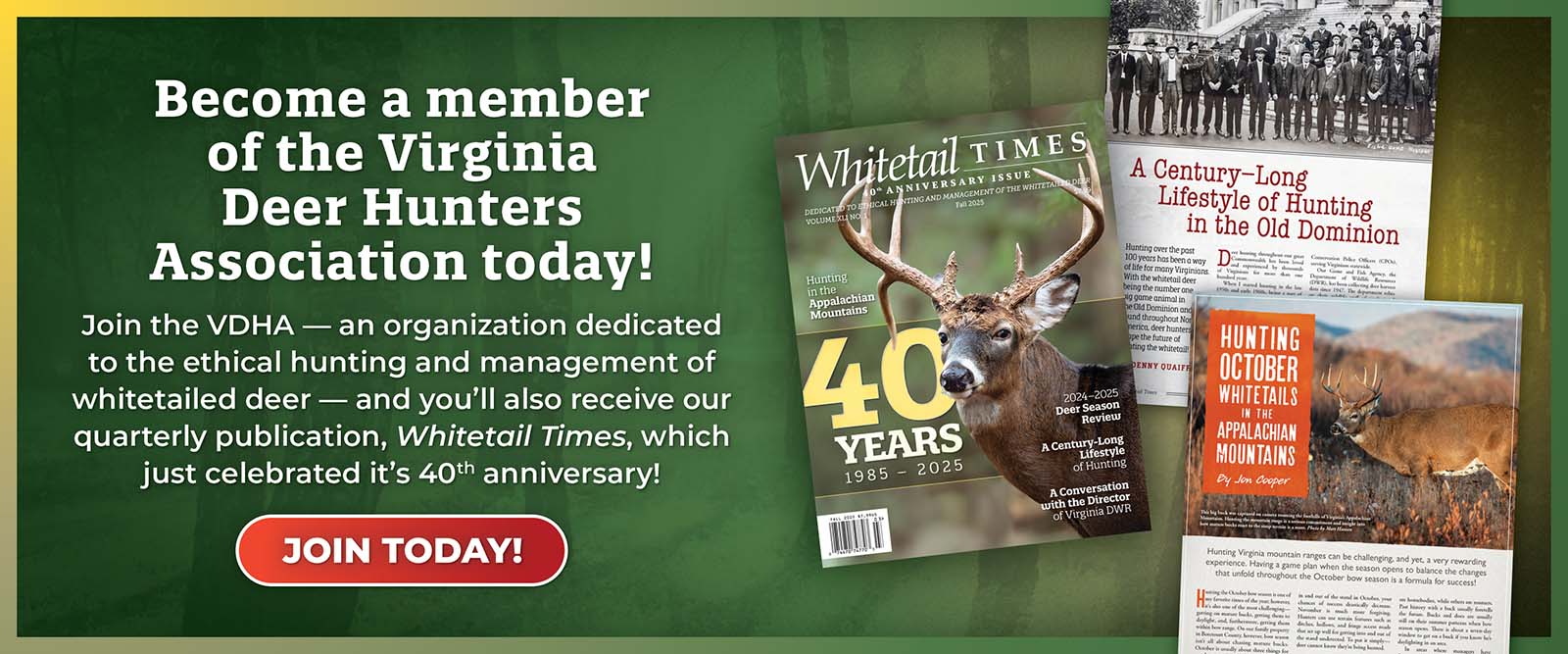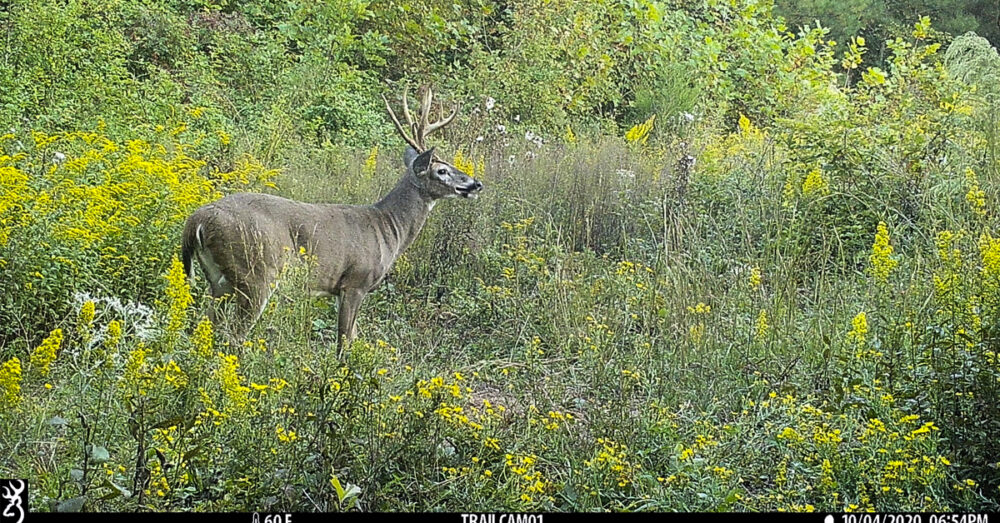
Numerous pictures of this buck, nicknamed “Train Wreck,” were captured throughout the summer traveling with a bachelor group of six. This picture on October 4 was the last picture taken before he showed up on November 1. That proved to be the final chapter in a story that had been followed for several months.
By Denny Quaiff for Whitetail Times
It was the second day of the 2020 early muzzleloader season and the sun had just set in the western skyline. The southwest wind was perfect for my stand location and with the last half hour of legal shooting light remaining I had a good feeling. My attention was focused along the edge of a standing corn field when a big-bodied buck stepped out. The Zeiss 10×42 field glasses dialed in a buck that I had nicknamed “Train Wreck” from trail camera studies throughout the summer.
This was my first season hunting with the CVA .45/70 Scout that was converted to a smokeless muzzleloader. The 140-yard shot felt good and knocked him down. However, like most big bucks, his will to live got him back up and a short 50- to 60-yard blood trail ended a story that I had been following for several months.
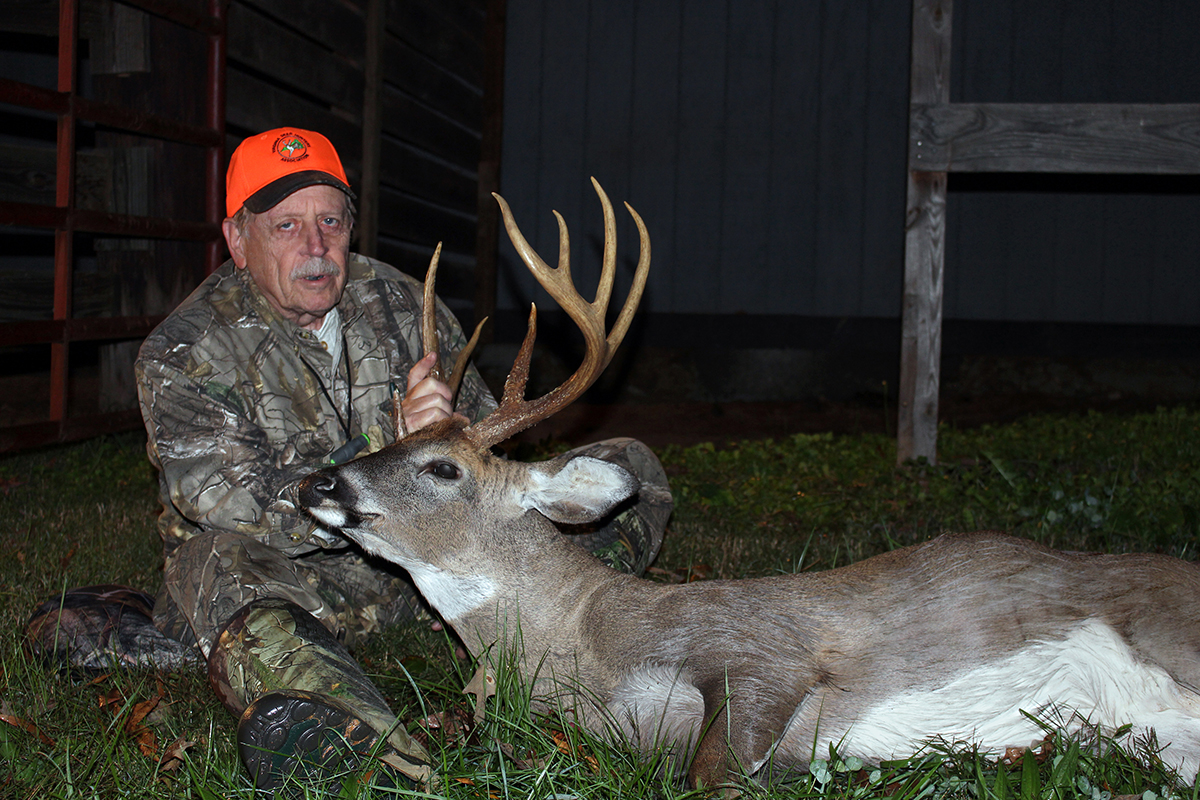
The decision to shoot or not shoot often results in a five-second judgment call. The trail camera studies of “Train Wreck” put him in the rifle scope’s cross-hairs without hesitation. Photo by Lacey Sullivan
Pattern Pre-Rut Bucks
In early June I started capturing pictures of a buck that was developing a very strange set of antlers. His left side was very typical with long tines. The right side was very non-typical and really got my attention.
After sharing the pictures with DWR’s Deer Project Coordinator Matt Knox, we agreed that this right antler disfigurement most likely resulted from a previous injury. When bucks grow antlers like this, the injury is often sustained from the opposite side front or rear leg that has been broken or from amputation. Another injury that will cause abnormal antlers results from injuries to a deer’s pedicle or skull.
My trail camera pictures never revealed any damage to the buck’s legs. Therefore, the best judgment would be prior damage to the pedicle or skull had produced the right antler abnormalities. In an article published by Brian Murphy in Game and Fish magazine, the common causes of the skull/pedicle injuries include fighting during the breeding season and the loss of all or a portion of the pedicle during antler shedding. Future abnormal antler development like this will more than likely continue over the years. That was the deciding factor that put “Train Wreck” on my list of target bucks when the season opened.
Although my cameras captured pictures of the buck with the unusual rack and five other bucks traveling together throughout the summer, my last picture came on October 4. The first time I laid eyes on him was November 1. This all played out within 350 yards of where numerous pictures were captured.
Mature bucks are never far from their prime food sources during the pre-rut. They are building body fat for the stressful full-blown rut that is fast approaching. This timeline is one of the few opportunities for hunters to pattern bucks that are still on the food source within their home range.
This is a fine example of how my firsthand knowledge of this buck left me with no uncertainty. The decision to shoot this buck had played out endless times in my mind over the past several months. My camera study made it easy to identify him at first glance, which meets all of the Quality Deer Management (QDM) guideline our club stands behind.
“The Real Trophy” is the title of a column written by Dr. R. Larry Marchinton and Joe Hamilton. Marchinton and Hamilton said, “Prior to the advent of Quality Deer Management, yearling bucks comprised 70 to 90 percent of annual harvest throughout much of the whitetail’s range.” They went on to say, “In those days of traditional deer management, most 2 1/2 -year-old bucks were considered trophies due to the fact that they were rare and usually larger than the yearlings.” Today Quality Deer Management guidelines can diversify with harvest selection for different clubs and landowners hunting free ranging whitetails. The general overview of this deer management plan is to take mature older age class bucks and harvest does to balance the resident deer herd’s carrying capacity; creating a better buck to doe ratios. These principles will help define and bring forth a more aggressive rut hunting experience.
QDM should not be confused with trophy hunting that is more commonly practiced in states that permit high fence enclosures that control which bucks are shot. High fence hunts are not guaranteed, but the success rate is high. Many of these trophy hunts are based on the Boone and Crockett score of the buck’s headgear and come with a steep price tag.
Keeping Track of Ruttin’ Bucks
When the whitetail rut is in full swing, all bets are off with regards to patterning bucks. Mature bucks extend their home range and move from one doe family to the next in search of a receptive doe. This was how luck played out for me when another of my target bucks let his guard down.
This big 10-pointer was captured on camera traveling with another bachelor group. His wide antler spread and large body left no doubt in my mind that he was a shooter by my standards. I had pictures of him throughout the summer, including one in which he was shedding his velvet antlers. I had one picture of him in late September, and after that he went off my radar screen. However, on November 11, I captured a picture of him on one of my cameras posted over a mile from where the last picture was taken in September.
Trail camera data during the rut is a big confidence builder, but finding a mature buck in that same area for long is an unlikely scenario. I continue to hunt the wind and look for the food sources that does frequent and ruttin’ bucks cruise in search of does.
On the afternoon of November 24, this all played out. I reached my tripod stand around 2:30. The northeast wind and falling temperatures set the stage for a hunt to remember. Does and fawns started coming into the field about one hour before sunset. The favorable wind conditions paid off and they never knew I was there.
About 4:30, I sighted movement of antlers along the tree line and my binoculars glassed a small six-point buck moving into the field. Over the next 30 minutes, the does moved out and left the small buck continuing to browse. Daylight was fading fast, and legal shooting light was set to end at 5:26. The young buck suddenly came to full alert and was staring down the end of the field.
Within a few minutes, he bolted out of the field, and I caught movement of a big-bodied deer slowly moving in my direction. A check of the time on my cell phone revealed 5:17. Under the low-light conditions, my binoculars were no help. I adjusted my rifle scope down to 4 power, enabling a good sight picture of the wide 10-pointer. With the cross hairs behind his shoulder, my .30-06 reported. The late Townsend Whelen, renowned gun writer and famous big game hunter once wrote, “The .30-06 is never a mistake.” Over the past 38 years the ought-six has been the horsepower behind my big game rifles and it never lets me down.
The picture captured on November 11 was two miles away, as the crow flies, from where the big 10-pointer was shot. With the prime rut winding down, this mature buck was extending his home range in search on an estrous doe. My trail camera pictures of this buck were everything I needed to know in case he showed up, and good luck played a big part in how this hunt unfolded. Like I said, when the rut is in full swing, all bets are off regarding hunting a particular buck. Discovering him on one of my cameras during daylight was all I needed to stay in the hunt.
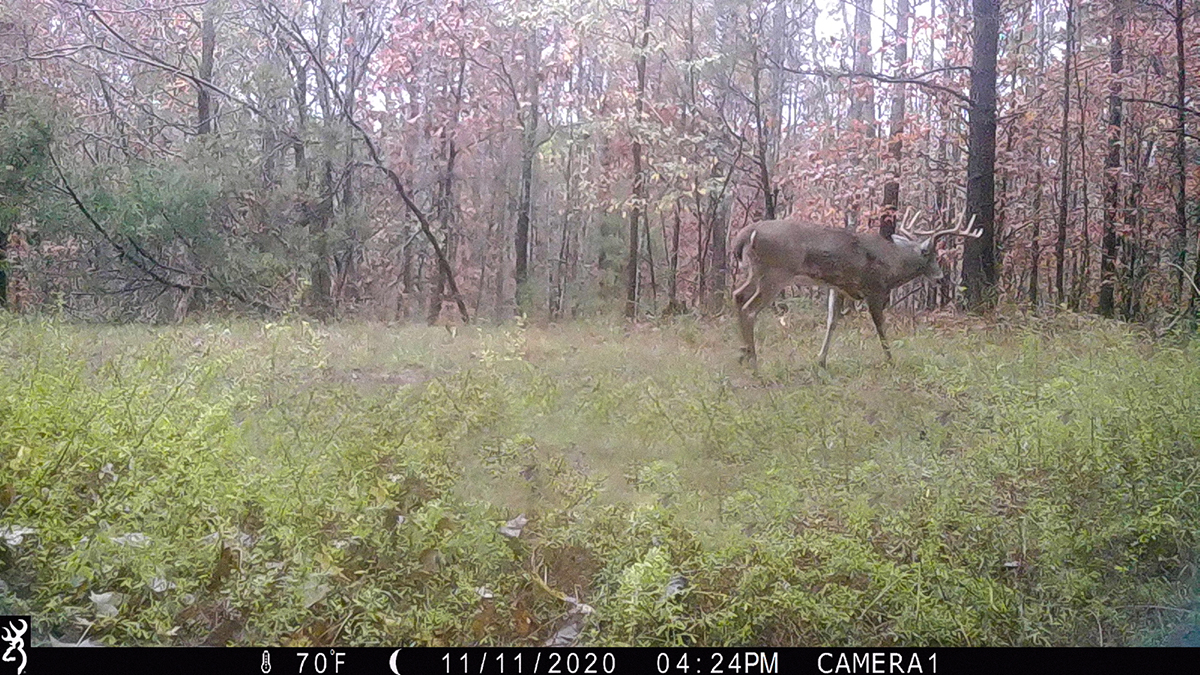
Mature bucks traveling during the prime rut very often seem to vanish. This picture, captured on November 11 of the wide 10-pointer, was two miles by way the crow flies from where he was shot on November 24.
Post Rut and Bucks That Got By
Hunting bucks in the post rut is a tall order. When December rolls around, buck activity is much like turning off a light switch. Seeing mature bucks walk on their own during daylight hours in the late season is not a common occurrence. I did encounter this on January 4, 2018. This all played out when a big 5 ½-year-old buck got caught chasing an estrous doe and offered me a killing shot, something I had never witnessed in the late season.
When a mature buck is captured on one of my cameras in the post rut, it reveals that he’s back in his home range. With that being said, locating his main food source and continuing to pay attention to the wind is the best game plan.
Another of my target bucks was the “Wide Eight” pictured on camera during the summer with the “Train Wreck” buck that I had taken during the early muzzleloader season. On December 23, which was my last hunt before Christmas, I pulled an SD card from one of my cameras. The wide eight-pointer that was last captured on September 26 was back on the same camera that found him throughout the summer.
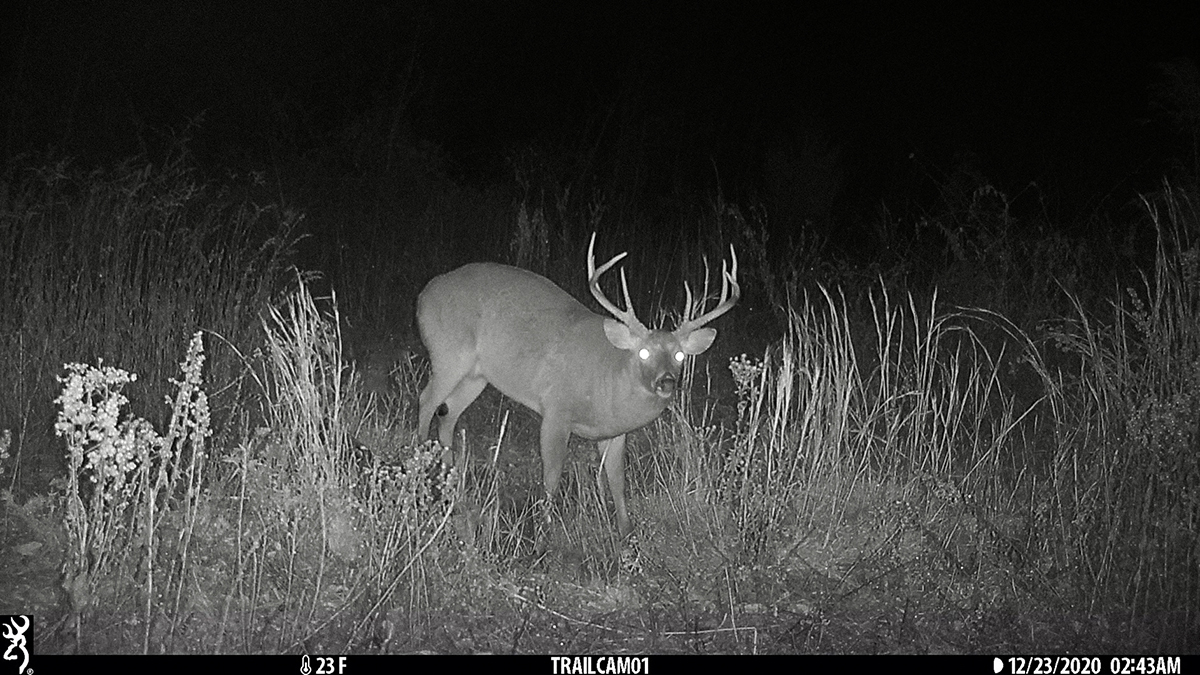
This wide eight-pointer was one of the author’s target bucks from summer pictures. However, he had completely gone off the radar screen since late September while traveling with “Train Wreck” and four other bucks. With his swollen neck, big belly, sway back and legs that looked too short for his body, the best estimate would be at least 5 ½ years old. Again, the trail camera photos set the stage for harvest selection of a mature animal if the opportunity presented itself.
Looking to back up my confidence and confirm my thinking of his age class, I shared the picture with my friend Brian Murphy, Vice President of Strategic Partnerships with HuntStand. The buck’s large body characterizes moved him beyond the 4 ½-year-old class. We both agreed that the buck was at least 5 ½ years old. Recognizing that aging bucks on the hoof is not a perfect science and comes with our best judgment, we concurred that he could be older. Aging bucks from trail camera pictures is a good benchmark to follow. If the buck is harvested, jawbone aging will confirm your estimate.
Between the holidays, family commitments, and lack of a favorable wind for what I believed to be the right stand location, the season was slipping away. The last day of the 2020-2021 season was January 2, and finally a WSW wind was posted on my weather app. That was what I needed.
The sunrise was 7:25 a.m. and sunset was 5:04 p.m., and I’m no stranger to sitting all day during the prime rut. Making this commitment on the last day is challenging and definitely a long shot. However, when the season ended, it was no big surprise that the “Wide Eight” never showed up.
Curious to know if the buck that had my attention was still in the area, I pulled the SD card on the way out and there he was again, on the move under the cover of darkness. Trail camera pictures of mature bucks that survive hunting pressure provide valuable data for the next fall season. After-season trail camera pictures render an inventory of bucks on the property that will help identify velvet-antlered bucks during the upcoming summer months.
Conclusion
Trail cameras are a low-impact management and scouting tool. After more than 25 years of running game cameras, the insight and awareness I have obtained from pictures concerning whitetail behavior has been invaluable to me. Conducting trail camera surveys of free-ranging whitetails before hunting season has become a big part of Quality Deer Management. Knowing what your property holds provides guidelines for setting management objectives.
Harvest selection plays a major role with any successful QDM program. The guidelines that follow harvest selection vary with different landowners, hunt clubs, and serious deer hunters. Some of the different requirements go with antler spread, beam length, and others call for the buck to have at least four points on one side. Making the right judgment call that often occurs within a few seconds is something that I take very seriously. Trail camera pictures have been a mainstay for me and help to guard against ground shrinkage after the shot is fired.
It’s very satisfying to say that my 2020-2021 deer season ended on a high note. After identifying six target bucks from hundreds of pictures and taking two of those deer before the first of December had my season off to a great start, plus the added excitement of capturing trail camera pictures of a target buck that had not been seen for three months. The results of 24/7 scouting that trail cameras provide leveled the playing field with this nocturnal buck that I don’t believe would have been discovered otherwise.
It would be safe to say that most of us have different objectives when it comes to deer hunting, and trail cameras have helped me to fine-tune my strategy. The most significant thing trail cameras have done for me is to offer realistic expectations of what a top-end shooter buck would be on the property that we hunt. Trail camera pictures offer a wealth of information and have helped to take my hunting to a high level of satisfaction!
©Virginia Deer Hunters Association. For attribution information and reprint rights, contact Denny Quaiff, Executive Director, VDHA.


